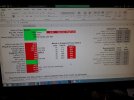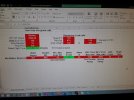Returningrcr
New Member
I am nearly completed building the Spadtothebone.org and about. I have made many revisions. Probably the biggest change I made is going to electric v.s. nitro. I chose to use the motor from the Timber X Night that I so successfully trashed. That motor is a BL10 and says it is 900Kv. I have several 2300Ma 4 cell batteries I have used with that motor. The 4 millimeter coroplast used for the build has a 66-inch wingspan, 51 inches long and 5.5 to 6 pounds. Now I am hoping this motor will propel this machine with a 10X8 prop instead of the 13X4 that was too long. Another big question I have is what size servos to use on the ailerons, elevator and rudder? I am going to use 2 servos for the big ailerons and the Spektrum 2300 Ma 4 c batteries along with the spektrum receiver that came with the Timber X night.
Any help with this challenge (at least for me), would be appreciated!
Any help with this challenge (at least for me), would be appreciated!


